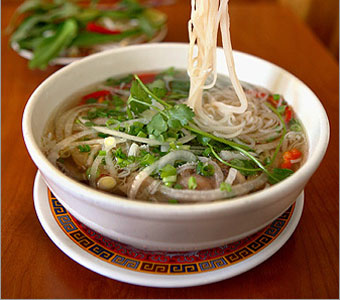 Without invitation, Sarah reaches over to pick at my larb gai. When it comes to meals, clothes, and perfume, my friend doesn’t recognise boundaries; she does, however, pay particular attention to the chicken on her fork, unhappy that it has been sliced, not minced. For Sarah, foreign cuisine is a marriage between her two passions: food and travelling. She’s tried the original in Laos and Thailand. This larb is wrong.
Without invitation, Sarah reaches over to pick at my larb gai. When it comes to meals, clothes, and perfume, my friend doesn’t recognise boundaries; she does, however, pay particular attention to the chicken on her fork, unhappy that it has been sliced, not minced. For Sarah, foreign cuisine is a marriage between her two passions: food and travelling. She’s tried the original in Laos and Thailand. This larb is wrong.
It’s the same at every restaurant. Somewhere, Sarah has had a better, more authentic version of the dish we are currently eating. Since she has travelled through every inhabitable continent sans North America, I take her word for it. The only exception is when we have Vietnamese beef noodle soup, also known as ‘pho’.
Sarah deliberately mispronounces it. ‘Let’s have faux.’ She has spent a summer backpacking through Southeast Asia, seeing much more of Vietnam than I have, but in our tiled and mirrored Victoria Street haunt, she adopts the role of pho-naïve because she’s not a daughter of Vietnamese migrants, whereas I am.
Thanks to my genes, I am a supposed expert on Vietnamese food. People come to me for restaurant recommendations and family nuoc cham recipes. ‘How do you get your chilli seeds to float?’ a Caucasian work colleague once asked me. When I admitted to having no idea, she cheerfully informed that Vietnamese mother-in-laws would judge my domestic skills on how well I managed this. It was one more item to add to the list of my inadequacies. Incorrect claw-like vice on chopsticks: check. Squawking Vietnamese like a Cho Lon person: check. Crappy nuoc cham unfit to give to Westerners with chilli seeds that sink to the bottom: check.
Every so often, Sarah and I meet up at her place for cooking sessions. Sarah’s mother joins us on her evenings off from their family-owned Balinese restaurant, teaching us how to make Indonesian curry and black sticky rice pudding, but usually it’s just Sarah and I, mucking about with their half-ransacked kitchen. One time, Sarah had to run out and buy new chopping boards because the old ones had migrated to the restaurant down the road. Thankfully, Sarah’s cookbooks aren’t Balinese; otherwise they too might have wandered off.
Her Poh’s Kitchen has been well-thumbed and sticky-noted. Masterchef’s Poh Ling Yeow is Malaysian Chinese, so Sarah and I refer to her when it comes to Petaling Street hawker food. We watch her show every week, and visit the website for recaps. Sarah has the Poh’s Kitchen App on her iPhone, so that when she goes grocery shopping at Yang Yangs, she can pick up the ingredients required for three-shot chicken.
Sarah and I avoid some of the other recipes. During one episode, Poh tried to make beetroot borscht with pirozhki; it was as if Alice Pung had compiled a collection of stories called Growing Up Eastern European in Australia. ‘No one cooks borscht like this,’ one viewer wrote on the show’s website. ‘And of course no one in [the] whole of Russia eats it with Pirozhki.’ Another added, ‘Yak! Without a doubt this is the worst borscht recipe I’ve ever seen.’
It’s not that Poh’s soup tastes bad—‘We had this last night and it was de-lish. Lovely earthy flavour. Very nice variation on a “traditional” theme’—it’s just that neither recipe nor cook were perceived as genuine. Pohlinka might have got away with taking liberties on a dish so distinctly Eastern European, but Poh cannot.
She has had more success with other international dishes, especially Asian ones, partially due to the fact that we viewers are more comfortable with a Malaysian Chinese experimenting with pad thai as opposed to matzah balls, partially due to the clever use of surrogate chefs such as Ragini Dey, and Emmanuel Mollois.
Inspired by Poh’s Malaysian fare, I show Sarah how to make traditional Vietnamese savoury crepes or ‘banh xeo’. The rough translation of banh xeo is ‘sizzling cake’, named for the crackle one hears when the crepe mixture is slapped around a hot pan. It’s one of my favourite dishes. Ma makes a dozen each session, piling them on top of each other, and encourages Ba and I to eat the fresh ones as soon as she flips them out.
Sarah has decided that the crepe mixture coats the pan more evenly when the flame is turned down, even though this sacrifices the trademark sizzle. We wrap our crepes in oak lettuce, and dip them in overly salty nuoc cham. When she asks me about the combination of flour, coconut cream, tumeric, and soda water, I keep mum. How do I break it to her? Like all of my traditional recipes, my banh xeo comes from a cookbook rather than family.
